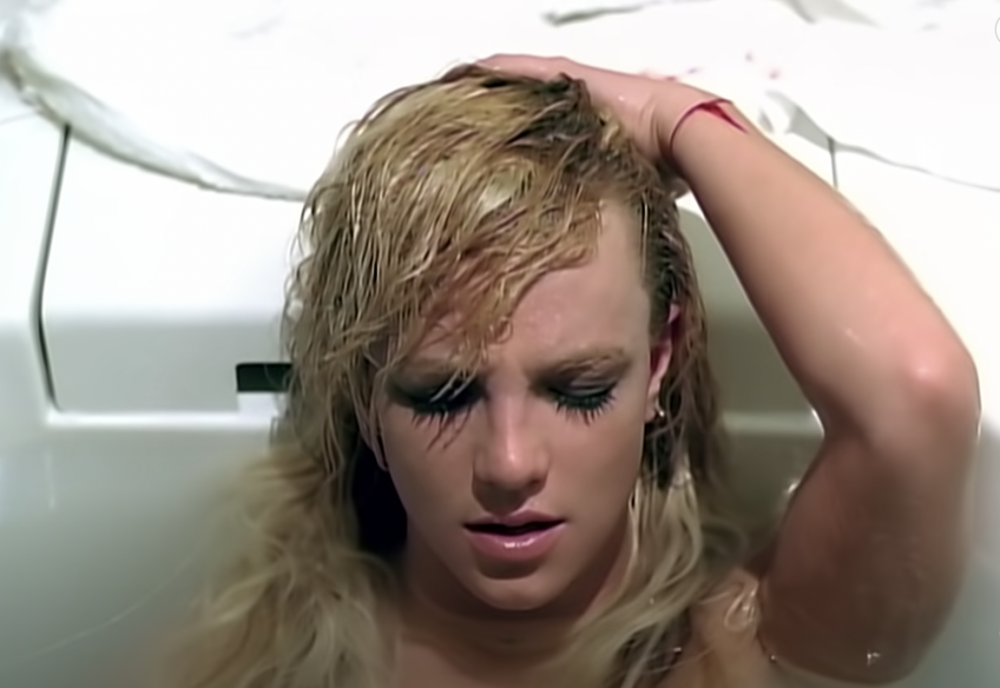Books & Culture
The Saga of Britney Spears Eerily Retells Verdi’s Classic Opera, “La Traviata”
The parallels between Spears and Violetta indict powerful men wreaking havoc in the lives of young women

The 1999 Video Music Awards were operatic by design: In honor of the burgeoning new millennium, MTV rented out the grandest of all possible venues, the Metropolitan Opera. Under the sputnik chandeliers, host Chris Rock joked (presciently) that he was the first Black man to be onstage at the Met without a mop. An opening number featured the mashup of Carl Orff’s Carmina Burana and Kid Rock’s Moonman-nominated “Bawitdaba.”
And, of course, there was Britney.
Had she been a debutante in lieu of a pop star, 1999 would have been Britney Spears’s coming-out season. Her maiden single, “…Baby One More Time,” debuted at the end of 1998 to near-instantaneous media saturation. Her pigtails—secured in fuzzy pink, chastity-belt scrunchies—bounced in time to the music. Her midriff-baring Catholic schoolgirl skirt swayed lasciviously in the music video. When she sang that her loneliness was killing her, it came off as coyly ironic, even smug, in the face of her ubiquity. At least, that’s how it seemed to me, a cynical teenager cast more in the mould of Daria than TRL.
Still, I remember those VMAs. I’d grown up with opera. I loved its grand gestures and sweeping emotions. I also still had one foot in the world of Billboard 100, even though my tastes ran more towards Beastie Boys and Hole.
Underneath my black hair dye and oversized turtlenecks, I saw Britney for who she was: she was no Violetta.
I remember the ad campaign that MTV ran in advance of the broadcast. The glossy photos, scattered between pages of Entertainment Weekly, Rolling Stone, Twist, and YM featured a baby-faced Britney alongside legends like Janet Jackson, David Bowie, and Madonna. Paying homage to that year’s venue, each star was photographed in costumes that recreated the look and feel of an opera. Jackson was Cleopatra in Handel’s Giulio Cesare; Bowie was Mephistopheles in Gounod’s Faust; Madonna, that most Italianate of all divas, was Bellini’s Norma.
Britney had been dressed up to look like Violetta, the synonymous heroine of Verdi’s La Traviata and a character oft-recycled in pop culture (see: Julia Roberts in Pretty Woman and Nicole Kidman in Moulin Rouge). Here was her narrative: Despite being a courtesan, Violetta was a “good girl.” A romantic, just doing her best in one of the two roles available to women in 19th-century Paris. Underneath my black hair dye and oversized turtlenecks, I saw Britney for who she was: she was no Violetta. She was a Carmen, the titular seductress of Bizet’s opera who gyrated her hips and might feign innocence but in actuality knew exactly what she was doing.
The photo itself gave it away: Britney looked out of place, a plastic deer caught in the headlights of a more sophisticated art form. Her face was overly made up, thick rims of black eyeliner that shouted “anachronism!” against the rest of the set pieces, all meant to evoke a 19th-century Parisian salon. In a pair of lace gloves, fingers cut off, she held an oversized handkerchief, the must-have accessory for all tuberculosis-ridden courtesans of the era. It was clear to me that she had no idea what she was doing. She was a black hole cinched into a corset and crinolines.
Perhaps Spears was more consumed with surviving the opera than merely seeing it. For all of its grand gestures, and sweeping emotions, opera’s ability to sting, subjugate, shatter, and smother women is far more inconspicuous—and insidious. For an art form that is often criticized for being nothing like real life, the way that opera undoes women (as feminist philosopher Catherine Clément once described it) is surprisingly true to lived experience. Take Spears: in the span of a year, she shaved her head in a Tarzana beauty salon, attacked a paparazzo’s car with an umbrella, and initiated a custody dispute that resulted in six police cars, a helicopter, and a fire truck descending upon her house and an involuntary hospitalization.
Traviata is one of the best examples of this invisible hand doing artisan-level work. As a girl, I watched the action play out on a set of velvet fainting couches and crystal candelabras. I romanticized Violetta, wanted to be Violetta—the courtesan who lived a life of pleasure and excess, trading it for true love, only to die tragically of tuberculosis in the end. I was around the same age when, sick one night at my grandparents’ house, I asked my grandmother if I “had what Violetta had.” (I’d thought that my stomach bug was consumption.)
To some, they were toxic. To others, they were lucky. To everyone, they were stars.
Everyone romanticized Violetta. Courtesans were the highest rung on the ladder of sex work in their time; mistresses to dukes, generals, and (in the case of Madame de Pompadour) kings. They were worldly and beautiful, refined yet unabashed. Rather than abandon the traditional role of womanhood in that time, they subverted it. They traded on their sex according to its market value, sure, but they did it for liberty rather than security. To some, they were toxic. To others, they were lucky. To everyone, they were stars.
Still, as Verdi intimates in the opening act of Traviata, Violetta could still cry, cry, cry in her lonely heart. A great lover, she had yet to know great love. At the end of that first act, her party guests dispersing as dawn breaks, she sings that she is a poor, lonely woman abandoned to the wasteland of Paris, fated to the vortex of fame and pleasure until her last breath. But then she meets Alfredo, a bourgeois, naïve young man who is new to Paris and in love with Violetta beyond commercial interest. Perhaps she can, in fact, escape the vortex.
Verdi became interested in the plight of the “fallen woman” (a literal Traviata) after scandalously taking up with soprano Giuseppina Strepponi out of wedlock. However, he didn’t invent the story entirely on his own; it was based on the novel and subsequent stage play by Alexandre Dumas (the younger), La dame aux Camélias. Dumas, in turn, based the story on his affair with real-life courtesan Marie Duplessis, though the term “based on” does a lot of work here, turning Dumas’s alter-ego into the selfless hero for trying to rescue a fallen woman (while being part of the same system that issued the push). Nearly 170 years later, Alexander Chee would restore some balance to this story with his subversive, antiheroic Prussian tenor in The Queen of the Night, whose attempted proto-conservatorship of the novel’s heroine, Lilliet Berne, backfires—quite literally.
Her father gave her the news that he had accepted this recommendation on Britney’s behalf. She cried for an hour.
The Mickey Mouse Club is about as far away from the Parisian demimonde as you can get, and yet Britney’s own trajectory is not so different from that of Violetta’s—or Duplessis. Spears was 16 when she signed her contract with Jive records, roughly the same age that Duplessis was when she reached the upper echelons of Paris’s sex industry (two years after her father first began prostituting her to older men). The way Duplessis was financially “kept” and overtly sexualized by men many times her age isn’t that far off from the way male record executives marketed Spears and her music career: equal parts spun-sugar and sex. Both women also saw their abusive, alcoholic fathers take active roles in their careers: In reading Spears’s testimony of her father’s conservatorship abuse, my mind immediately went to Marin Duplessis selling his 14-year-old daughter to an octogenarian man in their village and eventually abandoning her in Paris.
In her testimony this summer before a Los Angeles probate judge, Spears likened the cycle of nonstop work, which was orchestrated by her father, to sex trafficking: “Making anyone work against their will, taking all their possessions away—credit card, cash, phone, passport—and placing them in a home where they work with the people who live with them.” She testified that she had worked nonstop between 2014 and 2018, first in a Las Vegas concert residency, then on a three-month, 31-show US tour. She had been forced on pain of legal action to go back to Las Vegas for another residency. When she said she needed a break, her psychiatrist put her on lithium and recommended a custom, private rehabilitation program in Beverly Hills that would cost Spears $60,000 a month. Her father gave her the news that he had accepted this recommendation on Britney’s behalf. She cried for an hour. He “loved every minute of it.”
A father factors into Traviata as well, though it’s not Violetta’s. Instead, it’s Alfredo’s father, Giorgio Germont, who meets Violetta at the cottagecore arcadia the pair have run off to. They’re in love—real, non-transactional love. But Alfredo’s father needs her to abandon the relationship: It’s all well and good for a man of his standing to have a dalliance or two. But this affair, held out in the open, masking itself as a respectable, loving relationship, had begun to threaten the family’s social status. Violetta, without much of a choice, relented, weeping over the loss.
“Cry, go on and cry,” Germont consoles her. “I know I’m asking you to make the greatest sacrifice.” The words are sad, perhaps contrite, even. But the cloying melody he sings is a different tune: Germont is happy and satisfied. He gets exactly what he wants, and loves every minute of it.
Much like Alfredo’s own vindication at Violetta’s downfall, we were, in 2003, thrilled to see an over-hyped starlet get hers on primetime TV.
Alfredo is unaware of this exchange that takes place between his father and his lover. Violetta leaves him a note, explaining that she’s returning to her old way of life, hoping that this will deter him from trying to win her back. Instead, Alfredo tracks her down at a friend’s party. Calling all of Violetta’s friends and admirers into the salon, he says that, as her former lover, it’s time for him to pay his debts, and asks everyone to be witnesses as he pays her back. He throws a fistful of francs into Violetta’s face, a symbolic insistence that their love was nothing more than economics and that she was nothing more than a prostitute. Violetta crumples.
In Britney Spears’s 2003 interview with Diane Sawyer, which was excerpted in this year’s documentary Framing Britney Spears, Sawyer gravely informs Spears that she must ask her about her 2002 breakup with Justin Timberlake. Spears accepts this with the demeanor of a penitent at confession.
“You did something that caused him so much pain, so much suffering,” Sawyer says with a slightly pained expression. “What did you do?”
When the 22-year-old Spears demurs, visible tears in her eyes, Sawyer presses on: “But you said, ‘I’ve only slept with one person in my whole life, two years into my relationship with Justin.’ And yet, he left the impression that you weren’t faithful, that you betrayed the relationship.” Britney, her chin resting in her right hand, responds: “I’m not technically saying he’s wrong, but I’m not technically saying he’s right, either.” She then turns to the camera with the same doe-eyed daze on her face that is seen in her Violetta portrait. “This was really awkward,” she says, without a trace of humor.
To paraphrase John Berger, we’re rarely, if ever, able to reconcile what we see with what we know. Much like Alfredo’s own vindication at Violetta’s downfall, we were, in 2003, thrilled to see an over-hyped starlet get hers on primetime TV. It was a similar gleeful schadenfreude that made her very public breakdown just four years later as compulsively watchable as Dynasty. As Variety executive editor Ramin Setoodeh told the New York Times, it was an era in which it “was almost like a sport to watch a woman self-destruct.”
It was an opera.
It’s easy to forget the humanity in that girl, and to think of her more as another role.
Years after watching Britney sing “…Baby One More Time” onstage at the Metropolitan Opera, I heard director Jonathan Miller speak about Traviata. He had just helmed a production for the Glimmerglass Festival in upstate New York: a staging that featured Violetta almost completely immobile in the final act. It’s there, on her deathbed, that she reunites with Alfredo in a swell of romantic crescendo. Their eyes lock and they cry out to each other. Yet Miller didn’t play this for romance, didn’t give in to the music video cinematography or caramelized sentiment. I asked him about this choice.
“Have you ever seen a late-stage tuberculosis patient?” Miller, who had also been a physician, asked in return.
I had not.
“They aren’t running halfway across a stage,” he explained. “She’d be lucky if she could get out of bed. And when Alfredo enters, he probably would have been shocked by the state of her room. It would have stank. She’d probably shat herself.” I think of all the times I’ve been in hospitals, even the nicest ones. There are still colostomy bags and biohazard bins. Little about death is dazzling. Little about watching women self-destruct is entertaining, especially in 2021.
At 14, it’s easy to think that a 17-year-old knows exactly what she’s doing. It’s easy to see her squeezed into a corset, hair full of ostrich feathers, and feel more protective of the ostrich feathers than the 17-year-old girl wearing them. It’s easy to forget the humanity in that girl, and to think of her more as another role. It’s only now, half a life later, that I realize how powerless all 17-year-old girls are. How such powerlessness obfuscates the adult men hidden behind the curtain.
Like Alfredo, we’re now realizing what has transpired offstage. The punishing work schedule Jamie Spears forced on his own daughter has been revealed. That Spears was forced onto birth control by her conservatorship is now public knowledge. As she said in her July 14 hearing, she thought they were trying to kill her.
Of all the songs in the Britney canon that resonate a bit differently in light of her recent court testimonies, I’m most struck by the operatics of 2009’s “Everytime.” Spears plays a version of herself in a storyline that feels heightened, baroque, and grotesque. She arrives at a hotel in a limo mobbed by fans and photographers, bathed in a sickly, acidic green light. She makes it through the crowd, though not without a few bumps and scratches, and moves through the bowels of the hotel’s back-channels in order to make it up to her room, fighting with her boyfriend the whole way.
Once in her suite, she gets into the hot tub, and notices the blood running through her hair — one of the blows from a rogue paparazzi camera. Her eyes roll shut as she slips under the water. Cut to her boyfriend discovering her unconscious body. Cut to the paramedics wheeling her out, fans still brandishing glossy magazines in hopes of an autograph. Cut to the doctors trying, and failing, to revive her. No glamour, no glitter. You can almost smell the latex and rubbing alcohol.
And then, in the final seconds of the video, we see Britney emerge from under the jacuzzi water, smiling with the carefree joy of an Herbal Essences ad. No blood, no hospital. Had the entire thing been a fantasy? If so, for whom? A public clamoring for women to come undone for their own entertainment? Or a woman sick of being the entertainer?








